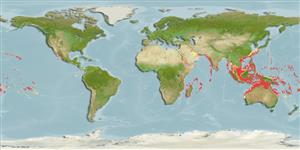Common names from other countries
Environment: milieu / climate zone / rango de profundidad / distribution range
Ecología
marino; salobre asociado a arrecife; rango de profundidad 3 - 158 m (Ref. 27665). Tropical; 32°N - 28°S
Indo-Pacific: Red Sea south to Algoa Bay, South Africa (Ref. 4329) and east to the Line, Marquesan, and Pitcairn islands, north to southern Japan and the Hawaiian Islands, south to New Zealand (Ref. 8879) and Rapa.
Tamaño / Peso / Age
Madurez: Lm ? range ? - ? cm
Max length : 15.5 cm TL macho / no sexado; (Ref. 90102)
Espinas dorsales (total) : 8; Radios blandos dorsales (total) : 9; Espinas anales: 2; Radios blandos anales: 8. Tan to light red brown in color, dusky scale margins; a brown mid-lateral stripe from tip of snout, through eye to upper caudal base (stripe may fade on peduncle); black spot at base of caudal fin (Ref. 2334, 4329). Further characterized by relatively broad midlateral dark stripe; yellow anterior margin on dorsal fin; green to blue iridescent shades on body when viewed with light at night; juvenile with yellowish head and belly; greatest depth of body 2.5-3.3 in SL (Ref. 90102).
Body shape (shape guide): short and / or deep; Cross section: compressed.
Occurs in clear water lagoon patch reefs and seaward reefs from the lower surge zone to a depth of 45 m (Ref. 1602). Benthopelagic (Ref. 58302). Solitary (Ref. 93839). Feeds at night on small benthic and free-swimming crustaceans (Ref. 1602).
Life cycle and mating behavior
Madurez | Reproducción | Puesta | Huevos | Fecundidad | Larva
Mouthbrooders (Ref. 240). Distinct pairing during courtship and spawning (Ref. 205).
Myers, R.F., 1991. Micronesian reef fishes. Second Ed. Coral Graphics, Barrigada, Guam. 298 p. (Ref. 1602)
IUCN Red List Status (Ref. 130435: Version 2025-1)
Threat to humans
Harmless
Human uses
Pesquerías: comercial; Acuario: Comercial
Herramientas
Special reports
Download XML
Fuentes de Internet
Estimates based on models
Preferred temperature (Referencia
123201): 23.9 - 28.9, mean 27.5 °C (based on 1254 cells).
Phylogenetic diversity index (Referencia
82804): PD
50 = 0.5312 [Uniqueness, from 0.5 = low to 2.0 = high].
Bayesian length-weight: a=0.01259 (0.00802 - 0.01977), b=3.14 (3.01 - 3.27), in cm total length, based on LWR estimates for this species & (Sub)family-body (Ref.
93245).
Nivel trófico (Referencia
69278): 3.5 ±0.0 se; based on diet studies.
Resiliencia (Referencia
120179): Alto, población duplicada en un tiempo mínimo inferior a 15 meses (Preliminary K or Fecundity.).
Fishing Vulnerability (Ref.
59153): Low vulnerability (10 of 100).
🛈
Nutrients (Ref.
124155): Calcium = 90.3 [44.4, 154.1] mg/100g; Iron = 0.753 [0.439, 1.305] mg/100g; Protein = 18.9 [17.7, 20.0] %; Omega3 = 0.157 [0.090, 0.276] g/100g; Selenium = 38.9 [19.3, 77.7] μg/100g; VitaminA = 53.3 [13.9, 199.5] μg/100g; Zinc = 1.51 [1.01, 2.19] mg/100g (wet weight);
